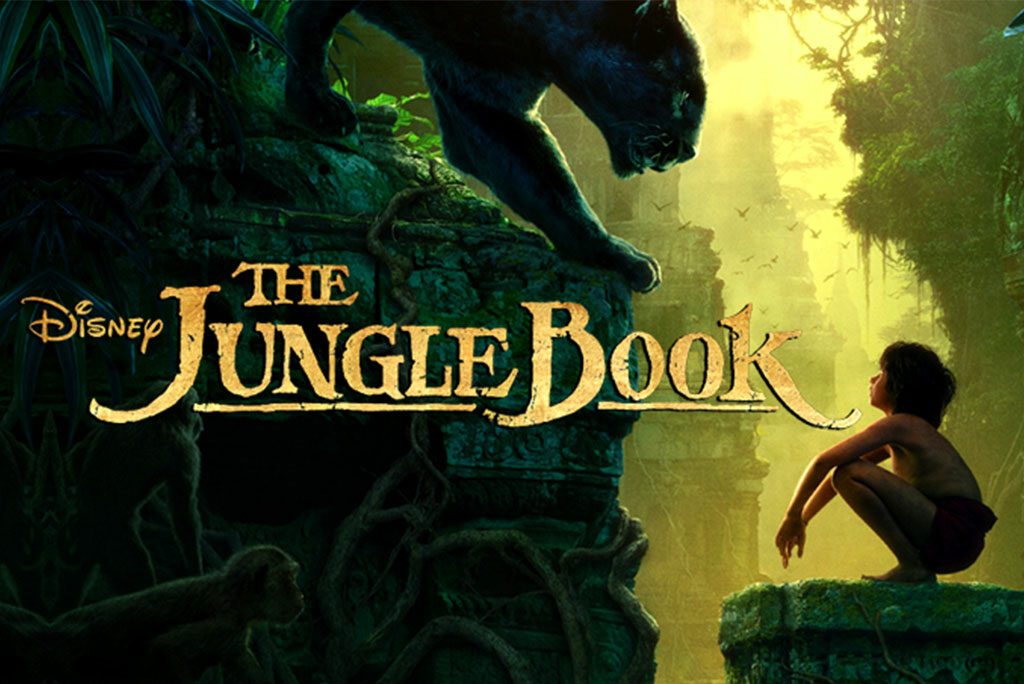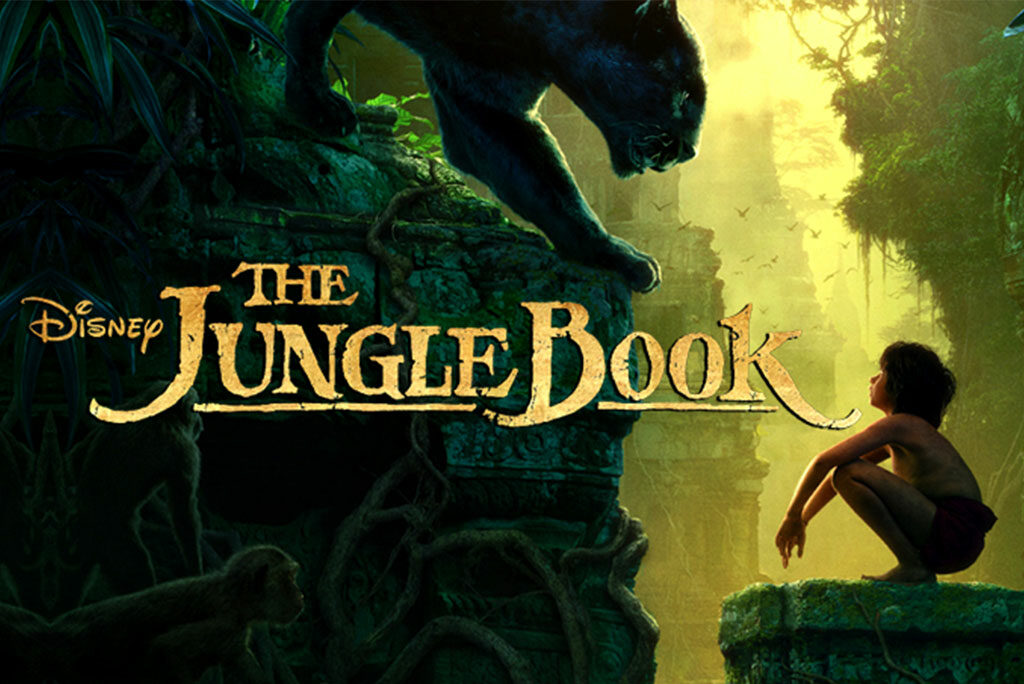
(Rated PG [Canada] and PG [MPAA] for some sequences of scary action and peril; directed by Jon Favreau; stars Neel Sethi, Bill Murray, Ben Kingsley, Lupita Nyong’o, Idris Elba, Scarlett Johansson and Christopher Walken; run time: 105 min.)
A reinvented jungle of visual delights
By Ted Giese
Jon Favreau’s “The Jungle Book” is a remake of the 1967 classic Disney cartoon about the adventures of a small boy, Mowgli (Neel Sethi), who was raised by wolves in the jungles of India. The story revolves around the friendly, talking animals who are escorting him to a local “man-village” for his protection and safety.
Favreau is no stranger to children’s films. He directed Will Ferrell in the nostalgia-heavy Christmas film “Elf” (2003), the young pre-“Hunger Games” (2012-15) and “Twilight” (2008-12) stars Josh Hutcherson and Kristen Stewart in “Zathura: A Space Adventure” (2005), and does an admirable job of tackling Disney’s “The Jungle Book” by wedding computer-generated imagery (CGI) and live-action. His biggest success, however, was the MARVEL studio film “Iron Man” (2008), which kicked off the modern super-hero craze.
One of the first questions viewers might ask about this new version of “The Jungle Book” is whether it is appropriate for children. As with all the live-action versions of Disney classics, they instantly become more intense when they move away from their cartoon roots. Favreau’s “The Jungle Book” is no exception. It is a darker film than the original, and the dangers faced by the “man-cub” Mowgli from the murderous tiger Shere Khan (Idris Elba), the beguiling python Kaa (Scarlett Johansson) and the covetous, conniving ape King Louie (Christopher Walken) are all more threatening. Young children will be better off watching the cartoon original before venturing into Favreau’s masterfully-crafted CGI jungle.
Disney’s recent success in live-action films started with its 2003 film “Pirates of the Caribbean: The Curse of the Black Pearl,” starring Johnny Depp and based on the popular Disney theme-park attraction. From there, the entertainment conglomerate set its eyes on re-marketing its classic cartoon catalog. In 2010, Disney released Tim Burton’s live-action/CGI take on “Alice in Wonderland,” Disney’s 1951 animated film based on the Lewis Carroll novel. (A sequel, “Alice Through the Looking Glass,” by director James Bobin — with Johnny Depp reprising his 2010 role as the Mad Hatter — will be in theaters this May.) Next was a rather loose adaptation of “Sleeping Beauty” (1959), “Maleficent” (2014), starring Angelina Jolie. In 2015, Disney released a live-action remake of its cartoon “Cinderella” (1950) directed by Kenneth Branagh, who also directed the MARVEL comic book film “Thor” (2011) for Disney.
More nostalgia-driven films like Favreau’s “The Jungle Book” are in the works. This year audiences can expect to see a remake of “Pete’s Dragon” (1977), and in 2017 Disney will release a new live-action version of its Oscar-winning film “Beauty and the Beast” (1991) starring Emma Watson as Belle. Essentially Disney has three irons in the fire: its MARVEL comic-book franchise, its classic-cartoon and family-film catalog, and the newly acquired “Star Wars” franchise. The challenge will be to maintain quality and interest as it releases multiple offerings each year.
That said, Favreau’s “The Jungle Book” is just this sort of high-quality film audiences expect. While it might lack the charm of Louis Prima as King Louie singing, “I Wanna Be Like You,” it makes up for it in its only live-action performer, Neel Sethi, who turns in a charming performance as Mowgli. The voice acting of Bill Murray as the bear Baloo, and Ben Kingsley as the black panther Bagheera — the film’s narrator and Mowgli’s benefactor and protector — are likewise charming and well-suited for the film. Murray as Baloo is less brash and wittier compared to the 1967 performance of Phil Harris, who struck a chord somewhere between Foghorn Leghorn and John Wayne. Here, Murray is still a crooner casually singing with Mowgli “The Bear Necessities,” yet Favreau directs him in such a way that Baloo is more tender and thoughtful as he teaches the young boy the laws of the jungle. What viewers get is a film that is darker in the dark parts and lighter in the light parts. This contrast between gentle tenderness and danger helps make the action more meaningful and dramatic when it springs to life on the big screen.
Another question viewers might have about this new version of “The Jungle Book” is whether it is more or less faithful to the 1894 Rudyard Kipling book of the same name. As with the original Disney cartoon, Favreau’s “The Jungle Book” is only loosely based on Kipling’s book. The 1967 cartoon was a product of its time, incorporating satirical jabs at the British Empire’s colonial history while at the same time finding a way to reference the British pop-rock band The Beatles, incorporating them into a wake of vultures eager to adopt Mowgli.
Favreau’s film likewise is a product of its time, reinterpreting Kipling’s theme of “identity” and “belonging” through Mowgli’s struggle to belong — a boy rejected by the wolf pack for being too much like a man and then rejected from the village of the men for being too much like a wolf — making “The Jungle Book” into a story about finding “identity” and “belonging” in inclusion. Where Kipling has Mowgli confront his sworn enemy Shere Khan the tiger, armed only with his cleverness and the help of his wolf brothers, Favreau has all the animals of the jungle turn on Shere Khan as they collectively recite the Law of the Jungle:
“Now this is the law of the jungle, as old and as true as the sky, And the wolf that shall keep it may prosper, but the wolf that shall break it must die. As the creeper that girdles the tree trunk, the law runneth forward and back, For the strength of the pack is the wolf, and the strength of the wolf is the pack.”
Essentially they are not bears, panthers, elephants and porcupines, but they all identify as wolves, creating the ultimate “belonging” Mowgli seeks. This is very different when compared to Kipling’s Mowgli, who is heroic and resourceful, doing the unexpected, and acting with limited help while dealing with Shere Khan. In Kipling’s book, Mowgli is becoming a man; in Favreau’s film, Mowgli isn’t allowed to grow up just yet (perhaps foreshadowing a sequel). And unlike the 1967 Disney cartoon which saw Mowgli go to the man-village where he would best belong, by the end of this film Mowgli lives with contentment in the jungle, finally finding his place with the animals. While sharing similar elements, the 1967 cartoon, this film and the book are all quite different. Kipling’s book is more complex and contains an additional theme of atonement, which will be very attractive to Christians. If viewers enjoy Favreau’s film or have a soft spot for the 1967 original cartoon, they may also find it interesting to visit or revisit the Mowgli portion of Kipling’s book.
In a society obsessed with “identity politics,” Christian viewers of “The Jungle Book” — with its popular, modern themes of “identity” and “belonging” — will want to remember their true personal identity is found in their Baptism into Christ Jesus. Christians of all kinds and various other segments of society will see Favreau’s film, and it is reasonable to expect that they will respond to its theme of identity and belonging in very different ways. On the one hand, modern secular progressives may see it as a film that promotes and champions their ideas of equality and identity: if a man-cub wants to identify as a wolf or if a porcupine or panther wants to identify as a wolf — that’s great! While on the other hand, viewers approaching the film from a scriptural vantage point might just as easily apply St. Paul’s words in Colossians 3:11 to the theme of identity found in the film. Paul talks about the nature of Christian identity and belonging by saying, “Here [within Christianity] there is not Greek and Jew, circumcised and uncircumcised, barbarian, Scythian, slave, free; but Christ is all, and in all.”
Parents watching this film with their older children will want to make this kind of scriptural connection, focusing it on their baptismal life in Christ but noting that there is a significant difference between being united by the “Law of the Jungle,” and being united in Christ. Unity in Christ “binds everything together in perfect harmony” (Colossians 3:14), whereas the Law, while useful, doesn’t save. As St. Paul says in Romans 8, “For God has done what the law, weakened by the flesh, could not do. By sending His own Son in the likeness of sinful flesh and for sin, He condemned sin in the flesh, in order that the righteous requirement of the law might be fulfilled in us, who walk not according to the flesh but according to the Spirit” (Romans 8:3-4). Favreau’s “The Jungle Book” provides no Christ character, only the “Law of the Jungle,” which is more like the law of Moses.
Is it fair to read a film like “The Jungle Book” in this way? Yes, audiences do it all the time. It’s called “reader response criticism,” where viewers respond to what they are watching based on what they have brought with them into the viewing experience. For Christians it will be their knowledge of scripture, their faith, their Christian upbringing and what they have been taught — their catechesis. The Christian viewer can apply all of these things with great confidence. As is always the case, a distinction between the fiction of the film and the truth of Scripture is to be maintained.
As Disney continues to bank hard on nostalgia with films like “The Jungle Book,” a question is emerging: Is there a “nostalgia bubble” like the tech bubble or the housing-market bubble? What happens when audiences grow tired of super heroes, “Star Wars” and re-packaged children’s cartoons made into CGI spectacles? Providing these kinds of films maintain the quality and excitement that Favreau has produced here, that bubble may yet be a way off from bursting. Until then, the collective pop-culture past of North America will carry on, being re-invented for the modern age and new audiences.
The Rev. Ted Giese (pastorted@sasktel.net) is associate pastor of Mount Olive Lutheran Church, Regina, Saskatchewan, Canada; a contributor to the Canadian Lutheran, Reporter Online and KFUO.org; and movie reviewer for the “Issues, Etc.” radio program. Follow Pastor Giese on Twitter @RevTedGiese.
Posted April 22, 2016
